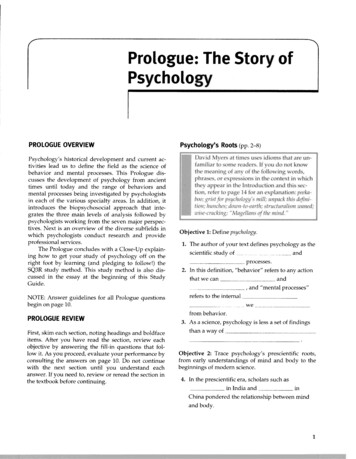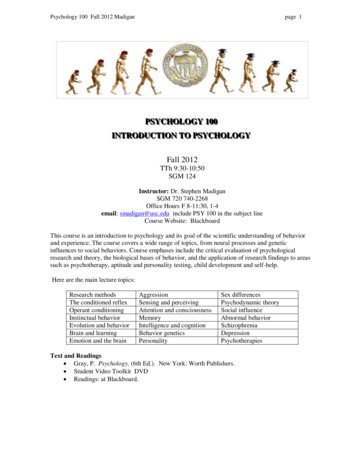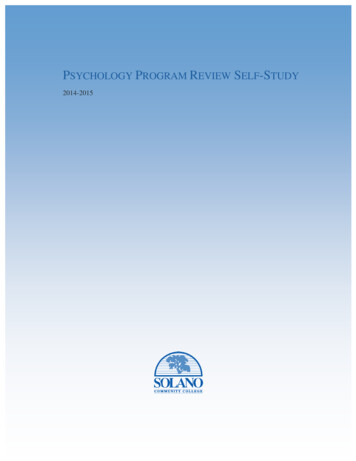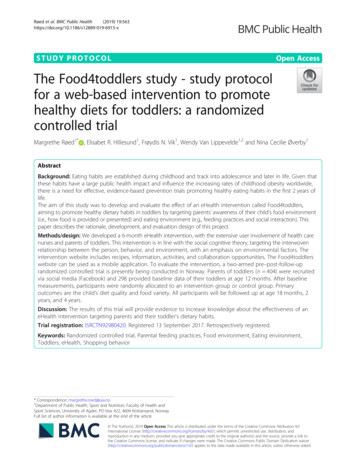
Transcription
International Journal of Scientific & Engineering Research, Volume 3, Issue 11, November-2012ISSN 2229-55181A STUDY ON THE PSYCHOLOGY OF AN INDIAN CUSTOMERTOWARDSE-BANKING WITH REFERENCE TO PUNE REGIONAbstractThe advancement in the technology paved new ways of delivering bank facilities to thecustomer, such as ATMs & Internet Banking. Hence banks have come a long way from itstraditional banking methods. This research paper throws light on the response to E-Bankingfacilities by Indian customers. As it has been more than three decades since the E-Bankingconcept came into existence, it becomes very much essential to study the current state of Internetbanking through the Indian context. The basic aim behind this research is to check the percentageof customers using online banking in Pune & its outskirts. It also aims at suggesting some waysfor making internet banking successful in the developing country like India. This paper depictsthe study of various E-Banking facilities that are provided by private sector, public sector & cooperative banks in Pune & its outskirts & in what way the Indian customers are respondingtowards the same.Key wordsE-Banking, Online banking facilities, Indian bank customer, attitudesIJSER 2012http://www.ijser.org
International Journal of Scientific & Engineering Research, Volume 3, Issue 11, November-2012ISSN 2229-55182IntroductionThe main purpose that banks have been serving since their inception is keeping our money safefor us. While keeping our money safe, they also let us earn a certain amount of interest on themoney deposited with them. Traditional banks have been doing this, and internet banks continuethe same function. The only difference is in the way the transactions are made.Online banking has been around for quite a few years. In fact, it was introduced in the 1980s andhas come a long way since then. The last decade has seen a profuse growth in internet bankingtransactions. Several pieces of legislation have also been introduced in this area.Though it began in the 1980s, it was only in the mid nineties that internet banking really caughton. What attracts customers to internet banking is the round the clock availability and ease oftransactions. Some customers have been known to turn to internet banking due to dissatisfactionwith standard procedures and practices. The total absence of human interaction appeals to somepeople. Some customers turn to internet banking facilities for security reasons. This is mainlybecause of customers being assured of banks' ability to keep transactions safe and secured.Most online transactions are made using the Internet Explorer interface. The Internet Explorerhas been around for more than ten years now.Internet banking (or E-banking) means any user with a personal computer and a browser can getconnected to his bank’s website to perform any of the virtual banking functions. In internetbanking system the bank has a centralized database that is web-enabled. All the services that thebank has permitted on the internet are displayed in menu. Any service can be selected and furtherinteraction is dictated by the nature of service. The traditional branch model of bank is nowgiving place to an alternative delivery channels with ATM network. Once the branch offices ofbank are interconnected through terrestrial or satellite links, there would be no physical identityfor any branch. It would be a borderless entity permitting anytime, anywhere and anyhowbanking.The network which connects the various locations and gives connectivity to the central officeIJSER 2012http://www.ijser.org
International Journal of Scientific & Engineering Research, Volume 3, Issue 11, November-2012ISSN 2229-55183within the organization is called intranet. These networks are limited to organizations for whichthey are set up. SWIFT is a live example of intranet application.The popular services covered under E-banking include:1. Automated Teller Machines2. Credit Cards,3. Debit Cards,4. Smart Cards,5. Electronic Funds Transfer (EFT) System,6. Cheques Truncation Payment System,7. Mobile Banking,8. Internet Banking,9. Telephone Banking, etc.The main advantages of E-banking are:1. The operating cost per unit services is lower for the banks.2. It offers convenience to customers as they are not required to go to the bank's premises.3. There is very low incidence of errors.4. The customer can obtain funds at any time from ATM machines.5. The credit cards and debit cards enable the Customers to obtain discounts from retail outlets.6. The customer can easily transfer the funds from one place to another place electronically.IJSER 2012http://www.ijser.org
International Journal of Scientific & Engineering Research, Volume 3, Issue 11, November-2012ISSN 2229-55184Research Objectives1. Understand the various services provided under the umbrella of E-Banking.2. Studying the psychological aspects of Indian customers which stop them from shifting towardsinternet banking.3. Suggesting ways for making E-Banking in India successful.Conceptual FrameworkThis study focuses on the relationship between socio-demographic characteristics like age,income, education, and beliefs & attitudes of bank customers towards E-Banking. The sociodemographic characteristics will be Independent Variables and beliefs & attitudes will beDependent eEducationComputer knowledgeBeliefs & Attitudes of IndianBank customers towardsE-BankingIJSER 2012http://www.ijser.org
International Journal of Scientific & Engineering Research, Volume 3, Issue 11, November-2012ISSN 2229-5518Literature ReviewOnline banking acceptance has gained special attention in academic studies during thepast five years as banking journals have devoted special issues on the topic (Mukherjeeand Nath, 2003). Two reasons can be established for online banking development anddiffusion. First, banks can save costs by offering online banking services. It has beenproven that online banking channel is the cheapest delivery channel for banking productsOnce established (Giglio, 2002.) Second, banks can reduce their branch networks anddownsize the number of service staff, which opens the way for online banking as manycustomers feel that branch banking requires too much of their time and effort. Therefore,time and cost savings and freedom from place have been found to be the main reasonsunderlying online banking acceptance (Howcroft, Hamilton and Hewer, 2002).Online banking offers many benefits to banks as well as to customers. However, whencompared globally the percentage of online users is not as high in the USA as otherregions of the world. There can be several reasons for this, the most obvious being thatcustomers need to have access to the internet in order to utilize the service. Also newonline users first need to learn how to use the service. Nonusers often complain thatonline banking has no social dimension, i.e. they are not served in the same way as in aface-to-face situation at a branch. Plus there are issues of security and privacy.The business benefit of the internet, according to Gow (1997), is to generate additionalrevenue, improve customer service, extend marketing, and increase cost saving. Banksenjoy these benefits as well. In an article entitled "Next-Generation Retail Banking"(Compaq, 2001), the business drivers for internet banking included:offline revenues by charging for online services and value-added services, such asproviding a portal for financial services linked to short-and long-term insurers,links to stock brokers, and links to foreign banks.net, customers servethemselves, negating the need for frontline staff. Savings are gained fromreductions in staff, reduction in branch sizes, and reduction in consumable costs:such as paper, ink cartridges, and other stationery.iring new customers. Customers looking for the flexibilityIJSER 2012http://www.ijser.org5
International Journal of Scientific & Engineering Research, Volume 3, Issue 11, November-2012ISSN 2229-55186and convenience offered by internet banking will be attracted to banks providingthe best services. Existing customers can be sold products that they do not have intheir portfolio such as a second credit card, life insurance, and home loans amongothers.can be facilitated by the data acquired and captured on the corporate database.Products and services can be customized to suit the needs of the customer orgroups of customers, thus facilitating customer loyalty.LV10038Dr. Nasim Z. Hosein Page 4 1/25/2010Agarwal et al. (2009) have undertaken a study to understand the perception and attitude of Indiancustomers and their satisfaction level with the variousservices offered through the e-bankingmode by banks in India. The study reveals that customer satisfaction with security and trustprovided by the e-banking site has the maximum impact on overall satisfaction of customers withe-banking, followed by customer satisfaction with convenience and ease of use.Stamoulis et al. (2002) studied the challenges faced by banks in assessingthe value of its main ebanking channel in operation. The study used a model which comprises five differentperspectives each having a corresponding set of met rics. These were used to assess the businessvalue along two viewpoints:(a) The internal view where the channel is considered as a resource whose utilization must bemaximized; and(b) The external view where the channel is an interface to the bank’s customer base whose usageshould directly support CRM.Proença et al. (2009) analyzed the impact of the use of Internet banking(i-banking) by customerson the relationship they develop with their main bank. The study made a relationship between thedimensions: the use of i-banking, and the relationship marketing approach in banking. Theresults showed that the relationship marketing approach is sensitive to the intensity of use of ibanking as well as to the diversity of operations performed there. The study revealed a strongIJSER 2012http://www.ijser.org
International Journal of Scientific & Engineering Research, Volume 3, Issue 11, November-2012ISSN 2229-55187association between the duration and maintenance of relationship and the diversity of places ofaccess to i-banking.Pikkarainen (2004) focused on the factors that influence online bankingacceptance in the light ofthe technology acceptance mode. The study revealed that perceived usefulness and amount ofinformation clearly have a positive effect on the use of online banking. The finding refers to thefact that consumers use online banking for the benefit it provides in comparison to other bankingdelivery channels.Sohail and Shanmugham (2003) studied customers’ preference for e-banking and the factorswhich they considered influenced its adoption. The study revealed that accessibility of Internet,awareness of e-banking, and customers’ reluctance to change are the factors that significantlyaffected the usage of e-banking in Malaysia. The study indicated greater promotional effort onthe part of banks to create greater awareness of e-banking and its benefits which is important forthe success of e-banking services patronage.Yang et al. (2009) described a comparative study about the issues in the current e-bankingservices among the young consumers between two nations: China and USA. The attitude andusage of young consumers will be a good indicator for thetrend of e-banking service in future. Different cultures and traditions play a role inthe development of e-banking industry among different nations. This comparativestudy provides insightful guidelines for the development of e-banking industry worldwide.Lee (2009) explored and integrated the various advantages of online banking to form a positivefactor named perceived benefit. In addition, drawing from perceived risk theory, five specificrisk facets—(1) Financial, (2) Security/privacy, (3) Performance, (4) Social, and (5) Time risk—were synthesized with perceived benefit, as well as integrated with the Technology AcceptanceModel (TAM) andTheory of Planned Behavior (TPB) model to propose a theoretical model to explain customers’intention to use online banking. The results indicated that the intention to use online banking isIJSER 2012http://www.ijser.org
International Journal of Scientific & Engineering Research, Volume 3, Issue 11, November-2012ISSN 2229-55188adversely affected mainly by the security/ privacy risk, as well as financial risk, and is positivelyaffected mainly by perceived benefit, attitude and perceived usefulness.Yang et al. (2007) investigated the recent trend and development of the application of e-banking(banking through Internet) in rural areas and its economic impact on local financial institutions.The study investigated how those smaller and community banks located in rural areas haveattempted to catch up with their counterparts in larger cities in terms of the application of ebanking, focusing on emerging issues and challenges. The study revealed that the e-bankingoperation is still in its infancy, for most of those small and local community banks conform tothe perception that the addition of new e-banking service will reduce banks’ operating cost andincrease the degree of customer satisfaction. But small and local community banks should speedup their effort in using some recent new technologies like mobile banking (m-banking) andpromotional efforts to increase their e-banking services.Liao and Cheung (2002) measured consumer attitudes toward Internet-based e-retail banking as afinancial innovation and to explore its viability and prospects on the demand side. The studyfound that individual expectations regarding accuracy, security, transaction speed, userfriendliness, user involvement, and convenience were the most important quality attributes in theperceived usefulness of Internet-based e-retail banking. In the study, too much importance wasattached to attributes like time and location convenience in promoting Internet e-retail banking inthe beginning, to the extent that tangible safety symbols like bricks-and-mortar offices wereneglected.IJSER 2012http://www.ijser.org
International Journal of Scientific & Engineering Research, Volume 3, Issue 11, November-2012ISSN 2229-55189Research MethodologyThe research work was carried out by the team of the MBA students of Global Business School& Research Centre, Tathawade, Pune. The students were distributed into 3 groups; each groupcontaining 4 members. Each group visited 5 banks of which 2 were private sector banks, 2 werepublic sector banks & 1 was co-operative bank. The bank customers as well as bankers of theconcerned banks were interviewed by each group of students.S.N.ResearchApproachFunction1.Sources of Data 1. Primary Source: Structured questionnaire via in-depth personal& tools for data interviews.collection2. Secondary Source: As per references2.Sampling PlanPopulation Definition- Bank customers, Bankers of variouscommercial & co operative banks in Pune & its outskirts.Sampling Design- Stratified & random sampling for bankers &bank customers.Sample Size- 15 banks; 60 Bank Customers & 15 BankersHypothesis1. Online Bill Payment is one of the facilities of online banking which has got the maximumusage.2. Lack of computer knowledge is the prime reason for not getting much response to E-Banking.3. People hesitate to use internet banking as there is a fear attached that individual details mayget public.4. “Convenience to Customers” was the main influence on bank’s decision to introduce internetbanking.5. Lack of initiative from banks is the main cause behind less usage of E-Banking services.6. Banks conduct face to face counseling to motivate customers to use internet banking.IJSER 2012http://www.ijser.org
International Journal of Scientific & Engineering Research, Volume 3, Issue 11, November-2012ISSN 2229-551810Findings1. It has been found out that 85 % of the bank customers are aware of E-Banking concept.2. It has been noticed that 30% customers are such who are not aware of the variousfacilities which come under the umbrella of E-Banking.3. It has been found out that 40% customers are such that they are aware of this E-Bankingconcept but still somewhat hesitant to make use of all the facilities of net banking.4. It has been observed that banks are not showing much interest to induce its customers touse E-Banking.5. It has been noticed that 20% customers are such that even though they possess thoroughknowledge regarding E-Banking, still want to visit the bank in person to complete thetransaction which otherwise can be done with the help of online banking.6. It has been observed that some co-operative banks are lagging behind in providing netbanking facility.7. It has been noticed that well established private banks have got dominance in providingbetter e-banking services.8. It has also been observed that despite being educated, there is a class of bank customerswho finds online banking ‘Unsafe.’IJSER 2012http://www.ijser.org
International Journal of Scientific & Engineering Research, Volume 3, Issue 11, November-2012ISSN 2229-551811DiscussionAlthough internet banking provides flexibility in performing financial transaction, fast and easy,however individuals are still reluctant to adopt the system because of several reasons.First, the security and privacy are two elements in the perceived risk. Without a properknowledge of the system, individuals are not interested to test the system. Perceived usefulness,ease of use and consumer awareness has positive impact on the intention to adopt internetbanking while perceived risk has negative impact on it.When online banking is perceived as useful, customer's intention to adopt it would be greater.Likewise bank customers are likely to adopt internet banking when it is easy to use. This showsthat bank customers anchor their online banking adoption intention to the beneficial outcomesand ease of use process of the system.This suggests that the need for banks to not only employ mechanisms to build trust for theirspecific e-banking website, but that banks should first take measures to educate their customers& manage general consumers’ perceptions of the risks of transacting on the internet.IJSER 2012http://www.ijser.org
International Journal of Scientific & Engineering Research, Volume 3, Issue 11, November-2012ISSN 2229-551812Limitations of the Study1. In view of the technicalities involved, it would be unrealistic to assume that all necessaryfacts have been gathered in the process of the study.2. Time was the biggest constraint. As far as the depth of the research paper topic isconcerned, it would be unfair to assume that the sufficient amount of data has beencollected within such a limited time frame.3. The data collection has been done from a limited geographical area. Hence the findings &conclusion have got their own limitations.4. The information given by the respondents might be biased because some of them mightnot be interested to give correct information.IJSER 2012http://www.ijser.org
International Journal of Scientific & Engineering Research, Volume 3, Issue 11, November-2012ISSN 2229-551813Conclusion E-banking has become a necessary survival weapon and is fundamentally changingthe banking industry worldwide. Today, the click of the mouse offers customers banking services at a much lower cost andalso empowers them with unprecedented freedom in choosing vendors for their financialservice needs. No country today has a choice-whether to implement E-banking or not given the globaland competitive nature of the economy. Banks have to upgrade and constantly think ofnew innovative customized packages and services to remain competitive. The invasion ofbanking by technology has created an information age and commoditization of bankingservices. Banks have come to realize that survival in the new e-economy depends on deliveringsome or all of their banking services on the Internet while continuing to supporttheir traditional infrastructure. The rise of E-banking is redefining business relationships and the most successful bankswill be those that can truly strengthen their relationship with their customers. Without any doubt, the international scope of E banking provides new growthperspectives and Internet business is a catalyst for new technologies and new businessprocesses. With rapid advances in telecommunication systems and digital technology, E-bankinghas become a strategic weapon for banks to remain profitable. It has been transformedbeyond what anyone could have foreseen 25 years ago. However, banks are uncertain about the regulatory framework for conducting E-businessand the regulatory and taxation issues for governing cyberspace presents formidableproblems. Developing such a system is not easy as the Internet is not organized geographically andit is almost meaningless to refer to a website as national or local. Any successful attemptat governing cyberspace will involve significant international cooperation. While the private sector and foreign banks have been fast in adopting Internet technologyin client servicing, there is a gradual trend for the major public sectors and numerouscooperative units to move in the same direction.IJSER 2012http://www.ijser.org
International Journal of Scientific & Engineering Research, Volume 3, Issue 11, November-2012ISSN 2229-551814Further ResearchThere is much scope for further research as far as the topic of this research paper is concerned.Some Indian bank customers are still reluctant to use online banking. They don’t believe in theauthenticity of net banking services. As this research has been done taking into account a verylimited data from private sector banks, public sector banks & co-operative banks in pune & itsoutskirts only, it has got its own limitations. On the basis of this paper, one can do thecomparative study of commercial & co-operative banks. There is also much scope for thecomparative study of the mentality of Indian Bank customers & foreign bank customers.IJSER 2012http://www.ijser.org
International Journal of Scientific & Engineering Research, Volume 3, Issue 11, November-2012ISSN 2229-551815Managerial ImplicationsDespite private & public sector banks have adopted advanced security measures such as mobilephone short message service (SMS), security notification, security token code, one-timepasswords etc., banks are not taking any effort in solving the core problem that is the customers’general distrust of the internet as a medium of exchange.This research also identified that there is still a class of bank customers who are not willing touse e-banking. Such consumers have low interest in e-banking. Banks can chalk out effectivemarketing strategies for e-banking adoption by concentrating such class of customers. Moreefforts should be taken by banks in undertaking advertising & promotional campaigns so thatgreater awareness among Indian consumers towards e-banking can be brought about.This research paper is beneficial for MBA students who are planning to take FinancialManagement as their specialization subject & who wish to do their summer project in bankingindustry. It throws light on the present scenario regarding online banking in India.IJSER 2012http://www.ijser.org
International Journal of Scientific & Engineering Research, Volume 3, Issue 11, November-2012ISSN 2229-551816Suggestions1. It is recommended that banks should take initiative in organizing some training campaigns fortheir customers to boost the use of internet banking.2. Banks should try to evaluate their performance periodically through the context of net bankingfacilities they provide.3. It is highly recommended that banks should observe easy methods to operate through onlinebanking; so that more & more customers can make use of net banking for various transactionswith ease.4. It is also recommended that cooperative banks should try to improve the net banking facilitiesto remain in the stiff competition & always try to motivate their customers to make more & moreuse of online banking as the customer-base of the cooperative banks is mainly from the countryside.IJSER 2012http://www.ijser.org
International Journal of Scientific & Engineering Research, Volume 3, Issue 11, November-2012ISSN 2229-551817Bibliography1. Britt P. (2006), “Internet Banking Advantage”, Bank Systems & Technology, Vol. 43,No. 8, p. 17.2. Bughin J. (2004), “Attack or Convert? Early Evidence from European On-line Banking”,International Journal of Management Science, Omega, Vol. 32, pp. 1-7.3. Centeno C. (2004), “Adoption of Internet Services in the Acceding and CandidateCountries, Lessons from the Internet Banking Case”, Telematics and Informatics, Vol.21, pp. 293-315.4. Dandapani K (2004), “Success and Failure in Web-Based Financial Services”,Communications of the ACM, Vol. 47, No. 5, pp. 31-33.5. De R and C. Padmanabhan (2002), “Internet Opens New Vistas for Indian Banks”6. Financial Express (2006), “Use of Internet in Banking is Becoming Compelling”, January18, Financial Express.7. Hannon K. (2006), “US News and World Report”, Vol. 140, No. 20, p. 59.8. Nelson D, R.R Adams, P Todd (1992). Perceived usefulness, ease of use and Usage ofInformation Technology: A replication. MIS Quarterly, Vol.16, No.2, Pp.227-2489. Agarwal R, V Sambamurthy, R.M.Stair (2000). Research report: the evolvingrelationship between general and specific computer self-efficacy: an empiricalassessment. Information Systems Research, Vol. 11, No. 4, pp. 418-30.10. Aladwani A.M. (2001). Online banking: a field study of drivers, development challenges,and expectations International Journal of Information Management, Vol. 21, pp. 213-22511. Amin H. (2007). Internet Banking Adoption among Young Intellectuals. Journal ofInternet Banking and Commerce, Vol. 12, No.312. Andrews L F, M.V.Boyle (2004). The influence of communication sources on perceivedrisk about purchasing online Proceedings of QualIT2004: International Conference onQualitative Research in IT & IT in Qualitative Research, Brisbane, Australia.13. Bauer H H, M Hammerschmidt, T Falk (2005).Measuring the quality of e-bankingportals. International Journal of Bank Marketing, Vol. 23, No. 2, pp. 153-75.14. Belkhamza Z, S.A.Wafa (2009). The Effect of Perceived Risk on the Intention to Use Ecommerce: The Case of Algeria. Journal of Internet Banking and Commerce, Vol. 14,No.1.IJSER 2012http://www.ijser.org
International Journal of Scientific & Engineering Research, Volume 3, Issue 11, November-2012ISSN 2229-55181815. Serva Benamati (2007). Trust and Distrust in Online Banking: Their Role in DevelopingCountries Information Technology for Development, Vol. 13, No. 2, pp. 161-175.16. Bradley L, K.Stewart (2003). Delphi Study of Internet banking.Marketing intelligenceand planning, Vol. 21, No.5, Pp. 272-281.17. Chau P.Y.K. (2001). Influence of computer attitude and self-efficacy on IT usagebehavior. Journal of End User Computing, Vol. 13, No. 1, pp. 26-33.18. Chin W.C. and P.A.Todd (1995).On the use, usefulness and ease of use of structuralequation modeling in MIS research: A note of caution.MIS Quarterly, Vol.19, No.2,Pp.237-246.19. Delvin J(1995). Technology and Innovation in Retail Banking Distribution.InternationalJournal of Bank Marketing, Vol. 13, pp.19-25.20. Diniz E. (1998). Web Banking in USA.Journal of Internet Banking and Commerce, Vol.3, No. 2.21. Doll Hendrickson W.J. and X Deng (1998).Using Davis's Perceived Usefulness and Easeof Use Instruments for Decision Making: A Confirmation and Multi-Group InvarianceAnalysis. Decision Science, Vol.29, No.4, Pp.839-869.22. Hair J.F. Anderson, R.E.Tatham, R.L. and W.C. Black (1998).Multivariate DataAnalysis. Upper Saddle River, NJ: Prentice-Hall.23. HongThong W, J.Y.L., W.M. Wongand, K.Y. Tam (2001). Determinant of useracceptance of digital libraries: an empirical examination of individual differences andsystem characteristics. Journal of Management Information Systems, Vol. 18, No. 3, pp.97-124.24. Hua G. (2009). An Experimental Investigation of Online Banking Adoption inChina.Journal of Internet Banking and Commerce, Vol. 14, No.1.25. Ibrahim E.E., M Joseph and K.I.N Ibeh (2006).Customers' perception of electronicservice delivery in the UK retail banking sector. International Journal of BankMarketing, Vol. 24, No. 7, pp. 475-493.26. Jane M.K., J.M. Hogarth and M.A. Hilgert (2004).The Adoption of Electronic BankingTechnologies by US Consumers. International Journal of Bank Marketing, Vol.22, No. 4,pp. 238-259.IJSER 2012http://www.ijser.org
International Journal of Scientific & Engineering Research, Volume 3, Issue 11, November-2012ISSN 2229-55181927. Johnson R.D. and G.M. Marakas (2000). Research reports: the role of behaviormodelingin computer skills acquisition: toward refinement of the model. Information SystemsResearch, Vol. 11, No. 4, pp. 402-17.28. Kaleem A and S. Ahmad (2008).Bankers' Perceptions of Electronic Banking inPakistan.Journal of Internet Banking and Commerce, Vol. 13, No.1.IJSER 2012http://www.ijser.org
International Journal of Scientific & Engineering Research, Volume 3, Issue 11, November-2012ISSN 2229-551820References1. http://www.sbi.co.in/user.html2. http://www.idbi.com/internetbanking.asp3. http://www.netpnb.com/index.html4. http://www.axisbank.co.in5. http://netbanking.hdfcbank.com/netbanking6. ng.aspx7. l8. ml9. http://www.jsbnet.in/jsbnet/index.html10. http://iobnet.co.in/11. /12. http://www.ftc.gov/edu13. http://www.worldjute.com/ebank.html14. A Research Paper on Bankers’ Perspectives On E-Banking by Dr. Himani Sharma15. A Research Paper on Dynamics of Innovation in E-Banking by Shreyan Singh, Sohrab SinghChhatwal, Taha, Mo
A STUDY ON THE PSYCHOLOGY OF AN INDIAN CUSTOMER TOWARDS E-BANKING WITH REFERENCE TO PUNE REGION Abstract The advancement in the technology paved new ways of delivering bank facilities to the customer, such as ATMs & Internet Banking. Hence banks h











